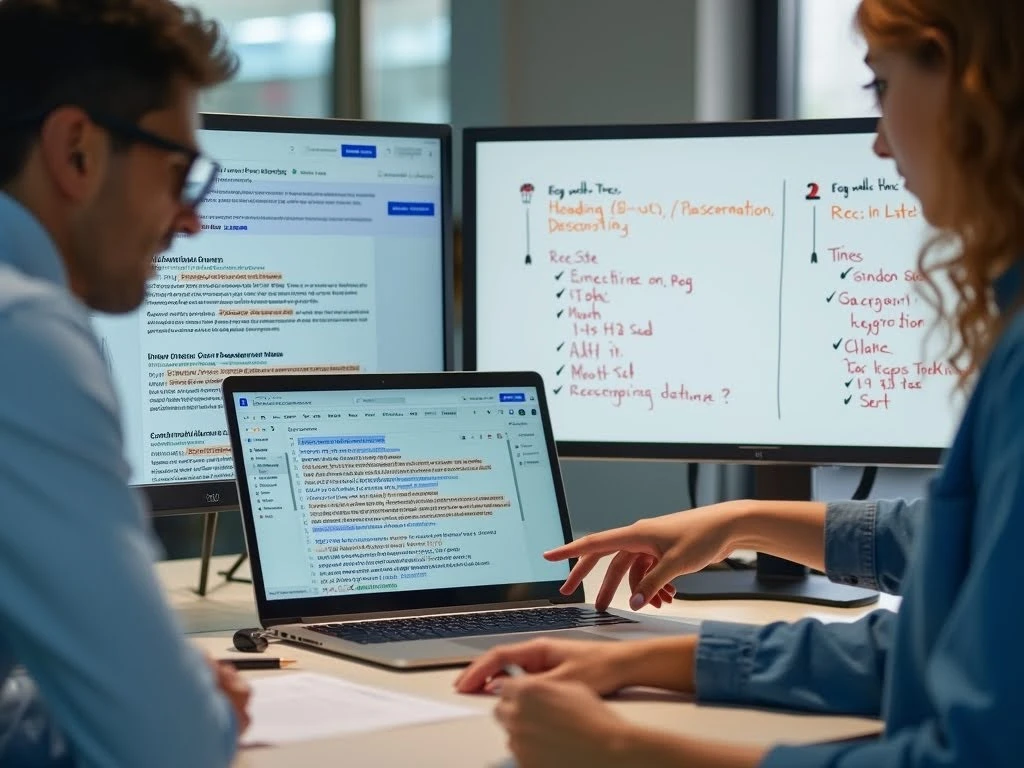How Does Keyword Placement Improve On-Page SEO?
Content optimization through strategic keyword placement is a crucial element of SEO that helps signal content relevance to search engines while maintaining a natural writing flow. Main keywords should ideally appear in both the head section and throughout the body of a webpage to enhance visibility.
When placed thoughtfully—in areas like the title tag, meta description, headers, and opening paragraphs—keywords help search engines quickly understand the topic and intent of your content. At the same time, a natural integration of these terms improves readability and keeps users engaged.
Overuse or awkward placement, on the other hand, can hurt both rankings and user experience. The goal is to balance optimization with clarity, ensuring your content is both search-friendly and valuable to readers. In this article, we’ll explore best practices for keyword placement and show you how it directly supports higher rankings and better on-page SEO performance.
Understanding Keyword Placement in SEO
Keyword placement in SEO refers to the strategic integration of relevant terms within a webpage to optimize its visibility in search results. Search engines analyze these placements to determine the topic and relevance of the content. Instead of simply counting keyword frequency, modern algorithms evaluate their positioning within headings, metadata, and structured content. This means businesses must go beyond basic keyword stuffing and implement a placement strategy that aligns with search engine guidelines. By doing so, they improve their chances of ranking higher while ensuring the content remains user-friendly.
A well-structured keyword strategy enhances both searchability and readability. Placing keywords naturally within key sections such as titles, introductions, and subheadings increases the likelihood of ranking for targeted terms. Additionally, variations of keywords, including long-tail and semantic terms, help create a more comprehensive content structure. This approach ensures that search engines understand the broader context of a page while reducing redundancy. Proper keyword distribution also prevents over-optimization penalties, which can negatively impact rankings.
Keyword placement should prioritize user intent and engagement. When users find content that directly answers their search queries, they are more likely to stay on the page, reducing bounce rates and improving dwell time. These engagement signals play a crucial role in ranking algorithms, reinforcing the importance of strategic keyword positioning. Businesses that integrate keywords seamlessly within informative and well-structured content build credibility and authority in their niche.
When structured correctly, keyword placement allows businesses to optimize for both search engines and user experience. Implementing a balanced approach ensures that keywords enhance, rather than disrupt, the natural flow of content.
The Role of Keyword Intent in On-Page SEO
Keyword intent plays a pivotal role in determining how content aligns with search queries. Every search query has an underlying purpose, and search engines prioritize pages that fulfill user expectations. Understanding search intent allows businesses to craft content that not only ranks well but also converts visitors into engaged readers or customers. The four primary types of keyword intent include:
- Informational: Users seek answers or explanations. These keywords often include "how to," "guide," or "what is."
- Navigational: Users look for a specific website or brand. Keywords in this category include brand names or product searches.
- Transactional: Users intend to complete an action, such as purchasing a product or signing up for a service.
- Commercial: Users are considering a purchase and comparing options. Keywords often include “best,” “vs.,” or “reviews.”
Matching keyword intent with on-page content ensures that businesses attract the right audience. Search engines evaluate engagement metrics, such as time on page and click-through rates, to determine if content meets user expectations. Pages that fail to align with intent may struggle to rank despite proper keyword placement.
Optimizing content for intent requires more than inserting relevant keywords—it involves structuring pages to guide users toward their goals. High-intent keywords should appear in call-to-action elements, product descriptions, and conversion-focused sections. Informational intent keywords, on the other hand, should be integrated into blog posts, FAQs, and educational content.
When businesses refine their keyword strategy based on intent, they create a more seamless user experience. A well-structured content plan ensures that keywords serve a functional role rather than being placed arbitrarily throughout the page.
Where to Place Keywords for Maximum Impact
Effective keyword placement strengthens search relevance while maintaining readability. Rather than stuffing keywords throughout a page, businesses should position them in high-impact locations where they provide the most value. Understanding where keywords have the strongest influence allows for optimized content that aligns with search engine expectations.
Title Tag & Meta Description
Title tags remain one of the most influential ranking factors. Placing the primary keyword at the beginning of the title tag increases visibility and improves click-through rates. Search engines highlight keywords in bold within search results, making them more noticeable to users. A well-structured title should balance SEO optimization and readability while clearly indicating the page’s topic.
Meta descriptions, while not direct ranking factors, influence engagement. A compelling description that includes on-page SEO keywords improves the likelihood of users clicking on the result. Ensuring that meta descriptions provide concise yet informative summaries enhances search relevance and user experience.
URL Structure
A clear and keyword-rich URL helps both search engines and users understand the content of a page. URLs should be short, descriptive, and optimized with primary keywords. Avoid using unnecessary characters or long strings of numbers, as they can make URLs appear unstructured. Well-optimized URLs improve indexing and ranking potential while enhancing usability.
Headings (H1-H6)
Headings structure content, making it easier for both users and search engines to navigate. Incorporating primary and secondary keywords within headings reinforces topic relevance. The H1 tag should contain the main keyword, as it establishes the page’s focus. Subheadings (H2-H6) should integrate related keywords naturally, ensuring that content remains engaging and informative.
Introduction & Conclusion
Keyword placement within the first 100 words of a page reinforces its topic. Introductions should include primary and secondary keywords while maintaining a natural tone. Similarly, conclusions should summarize the key points and reinforce keyword relevance. This strategic placement enhances search visibility while keeping content fluid and engaging.
Body Content
Keywords within the body should be distributed logically, ensuring that they complement rather than disrupt the flow of content. Overuse of keywords can lead to over-optimization penalties, so it is crucial to maintain balance. Integrating semantic variations and LSI keywords helps enhance topic depth while reducing redundancy.
Anchor Text & Internal Links
Internal linking improves site structure and crawlability while reinforcing keyword relevance. Using keyword-rich anchor text strengthens the connection between related pages, allowing search engines to understand topic relationships. For example, businesses offering SEO services should link to relevant pages that support their main content.
Image Alt Text & File Names
Search engines rely on alt text and file names to interpret images. Optimizing these elements with descriptive keywords improves accessibility and enhances image search rankings. File names should include relevant keywords to maximize visibility in search results.
Well-placed keywords establish a strong foundation for on-page optimization. Ensuring that each element serves a functional role enhances the overall effectiveness of an SEO strategy.
Optimizing Keyword Density Without Overstuffing
Keyword density refers to the percentage of times a keyword appears within a piece of content compared to the total word count. While keyword presence is important for search engines to understand content relevance, excessive repetition can negatively impact rankings. Modern search algorithms prioritize natural language processing, meaning content that reads unnaturally due to forced keyword insertion may be flagged as spam. The goal is to integrate keywords in a way that enhances readability while maintaining on-page SEO effectiveness.
Maintaining a balanced keyword density prevents over-optimization, which can harm rankings rather than improve them. The ideal approach is to place primary and secondary keywords strategically in impactful areas like headings, introductions, and anchor text. Instead of repeating the same term excessively, content should incorporate synonyms and related phrases to create a more natural reading experience. This method signals relevance to search engines while ensuring a seamless content flow for users.
Modern SEO best practices emphasize context over frequency. Google’s algorithms analyze semantic relevance and user intent, meaning that content should focus on delivering valuable information rather than merely including keywords. Using latent semantic indexing (LSI) keywords helps reinforce the topic without excessive repetition. Placing keywords naturally within subheadings, bullet points, and internal links strengthens content structure and engagement.
A well-balanced keyword strategy contributes to a page’s SEO performance and user experience. Instead of focusing on density alone, businesses should prioritize keyword placement and semantic relevance to create optimized yet readable content.
Semantic SEO & LSI Keywords for Stronger Relevance
Search engines have moved beyond basic keyword matching and now focus on semantic relationships between words and phrases. Latent Semantic Indexing (LSI) keywords help search engines understand content in context rather than relying on exact-match keywords. By incorporating related terms and variations, businesses can improve their content’s depth and increase its relevance for a broader range of search queries.
LSI keywords strengthen topic authority without requiring repetitive use of primary keywords. For example, a page about web design should include terms like "UI/UX," "responsive layouts," and "website optimization." These variations reinforce the subject matter while enhancing the user experience. Instead of stuffing a single keyword throughout the content, using semantically related phrases creates a more natural and informative piece.
Search engines assess topic comprehensiveness when ranking pages. Content that includes related keywords, industry terms, and structured data appears more authoritative and well-researched. Businesses should integrate long-tail keywords and phrase variations to align with search intent while ensuring a user-friendly experience.
Implementing semantic SEO ensures that content remains optimized for search engines and users. A strong keyword strategy should focus on relevance, readability, and context rather than frequency.
How a Digital Marketing Agency Can Help Optimize Keyword Placement
A well-planned keyword strategy requires expertise, data analysis, and continuous adjustments. Many businesses struggle with proper keyword placement, either over-optimizing or failing to use keywords effectively. Partnering with a digital marketing agency ensures that keyword integration aligns with search engine algorithms while maximizing engagement.
In-Depth Keyword Research & Strategy Development
Agencies conduct extensive keyword research to identify high-performing terms that align with search intent and user behavior. They analyze competitor strategies, search volume trends, and conversion-driven keywords to refine content optimization. This ensures that businesses target the most valuable keywords while avoiding ineffective or overly competitive terms.
Strategic Keyword Placement & On-Page Optimization
An agency optimizes titles, meta descriptions, headers, URLs, and content structure to enhance keyword effectiveness. By applying on-page best practices, agencies improve search visibility while maintaining readability. Keyword-rich anchor text and internal linking further strengthen page authority and navigation. Businesses benefit from a well-structured approach that ensures keywords contribute to both SEO performance and user engagement.
Content Optimization for Long-Term Success
SEO is an ongoing process that requires continuous updates and adjustments. Agencies track keyword performance and refine placement strategies based on search trends and algorithm updates. Through data-driven insights, they ensure that content remains competitive and adapts to changes in search behavior.
Technical SEO & Mobile Optimization
Beyond content, agencies optimize technical elements that impact keyword effectiveness. A well-structured site with fast-loading pages, mobile-friendly design, and clear navigation enhances SEO rankings. Implementing structured data, schema markup, and mobile-first indexing ensures that keywords perform well across all devices.
Businesses that leverage agency expertise gain a competitive edge in search rankings and user engagement. The right keyword strategy contributes to sustained online growth and better digital performance.
How Authority Solutions® Helps Businesses Optimize Keyword Strategies
Authority Solutions® specializes in on-page optimization, offering businesses a data-driven approach to strategic keyword placement. Our team conducts in-depth keyword research to identify high-impact terms that improve search visibility. By integrating primary and semantic keywords throughout your content, we help businesses maximize ranking potential while ensuring readability.
Our SEO services focus on optimizing key elements such as title tags, meta descriptions, URLs, internal links, and structured data. We ensure that keywords align with search intent and user experience, resulting in higher engagement and improved performance. Our expertise in content strategy and technical SEO ensures that every page is optimized for long-term success.
Beyond keyword placement, we enhance on-page and off-page strategies to improve overall domain authority. Our team applies advanced optimization techniques that align with Google’s evolving algorithms, ensuring that businesses maintain consistent online visibility. Whether optimizing existing content or developing new pages, we provide customized SEO solutions that drive measurable results.
Partnering with Authority Solutions® ensures that your business benefits from industry-leading expertise. Our approach combines keyword precision, technical SEO, and content strategy to create a sustainable and competitive online presence.
Conclusion
Strategic keyword placement plays a crucial role in on-page SEO by improving search visibility and user engagement. Businesses must focus on optimal keyword positioning rather than relying solely on density. Integrating primary, secondary, and semantic keywords within titles, headings, and internal links ensures content remains relevant and structured. When implemented correctly, keyword strategies enhance readability, ranking potential, and overall site performance.
Authority Solutions® provides businesses with expert SEO solutions that align with evolving search engine standards. Our team optimizes content structure, keyword distribution, and technical elements to ensure maximum visibility. Whether improving existing pages or developing a new SEO strategy, we help businesses achieve long-term success in search rankings. Contact us today to refine your keyword strategy and on-page optimization for better performance.
Frequently Asked Questions
How does keyword placement improve on-page SEO?
Keyword placement plays a key role in improving on-page SEO by helping search engines understand the topic and relevance of your content. Placing primary keywords in areas like the page title, meta description, headings, URL, and naturally throughout the body content increases visibility and ranking potential. Strategic placement ensures content reads smoothly for users while still signaling strong SEO intent, ultimately boosting both discoverability and engagement.
How many times should I use a keyword per page?
There is no fixed rule for keyword usage per page, but a natural balance is essential. Instead of focusing on keyword density, ensure that keywords appear in high-impact areas such as headings, introductions, and internal links. Overusing a specific keyword can make content seem unnatural and may trigger penalties. The best approach is to use semantic variations and related terms to enhance relevance.
What is the difference between on-page and off-page SEO?
The difference between on-page SEO and off-page SEO lies in their focus areas. On-page SEO involves optimizing elements within your website, such as meta tags, content, headings, and images. Off-page SEO, on the other hand, focuses on external signals like backlinks and social media engagement. Both strategies contribute to a successful SEO strategy, but on-page elements are foundational to a website’s search engine optimization success.
How can I find the best keywords for my content?
Using keyword research tools helps identify high-traffic and low-competition keywords for content optimization. Platforms like Google’s Keyword Planner provide insights into keyword rankings and search volume trends. When choosing a target keyword, consider search intent and competition level to maximize results. A well-researched keyword mapping strategy ensures content aligns with user search behavior and business goals.
Why is keyword in the title important for SEO?
Including a keyword in the title improves a page’s relevance and visibility in search engines. Search engines, like Google, prioritize titles when determining a page’s subject, making keyword placement in this area essential. Titles should be concise, engaging, and optimized around the keyword to encourage higher click-through rates. An effective title strategy enhances both SEO and user engagement.
How do I optimize my page for better rankings?
To optimize your page, focus on key elements of on-page SEO such as metadata, structured content, and internal linking. Use an on-page SEO checklist to ensure your content is properly formatted and includes strategically placed keywords. Other factors, such as page load speed and mobile-friendliness, also impact rankings. A comprehensive on-page SEO approach ensures your site remains competitive in search results.
Does image optimization affect SEO rankings?
Yes, image optimization plays a significant role in page SEO performance. Search engines analyze image SEO factors such as file names, alt text, and compression to improve accessibility and page speed. Optimized images contribute to faster load times, which is a key factor in ranking algorithms. Adding relevant keywords in alt text ensures that images support overall content relevance.
How does local SEO impact keyword placement?
Local SEO requires smart keyword usage to target location-based search queries. Businesses must optimize page content with geographic terms while maintaining a natural flow. Using location-specific keywords in meta descriptions, URLs, and headings helps search engines understand what your page is about. A strong local optimization strategy ensures visibility in first-page search results for relevant locations.
What role does page speed play in keyword optimization?
Page speed directly influences how search engines rank a website and how users engage with content. A slow page load speed can lead to higher bounce rates, reducing the effectiveness of keyword placement and overall SEO efforts. Optimizing site performance, including compressing images, minimizing redirects, and enabling caching, enhances search engine result rankings. Fast-loading pages improve user experience, increasing retention and conversions.
What are some advanced on-page SEO techniques for better keyword placement?
Implementing advanced on-page SEO techniques enhances keyword rankings and user engagement. These strategies include on-page analysis, structured data, and internal linking optimization. Using an on-page SEO checker helps assess keyword effectiveness and detect optimization gaps. Following a complete guide ensures that all critical SEO factors are addressed for maximum ranking potential.









